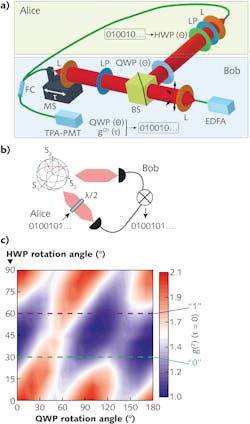Correlated unpolarized photons enable camouflaged secure communication

Secure communication is currently an important topic in global digital data communications. Done right, it safeguards the interaction of Internet of Things (IoT) devices as well as any private messaging between two parties. In parallel to the development of quantum computers, novel communication schemes such as quantum cryptography have been developed. Aside from quantum cryptography, chaos communication is another area of research that aims to achieve secure transfer of information on the basis of physical laws by exploiting two chaotic lasers and their synchronization, thus providing a measure of security directly in the physical layer.
A group of scientists from the Technical University of Darmstadt (Darmstadt, Germany) has pursued a third, distinct approach. Their idea is based essentially on three scientific areas: secure communication, quantum optics in the spirit of Hanbury-Brown and Twiss photon correlations (here in the sense of ghost metrology schemes), and classical optics in the spirit of the Stokes formalism and the Poincaré sphere.1
Ghost-polarization communication
The researchers developed an approach for a message encoding scheme between two parties—the well-known Alice and Bob—by exploiting the infinite number of polarization states of unpolarized thermal light on the Poincaré sphere, together with their correlation properties, to camouflage and recover a message. This scheme realizes a so-called ghost-polarization communication (GPC), named in analogy to other ghost modalities, which are based on photon correlations.
At first, the researchers investigated the intensity correlation coefficient g(2)(τ) of classical unpolarized broadband amplified spontaneous emission (ASE) light emitted by an erbium-doped fiber amplifier (EDFA) at 1550 nm (see figure). They manipulated the light’s instantaneous polarization state using various polarization optics in the beam paths of a Hanbury-Brown and Twiss-like ghost-polarimetry setup using ultrafast two-photon absorption in a photomultiplier tube (PMT).
The observed polarization state modifications were not only in excellent agreement with an analytical model based on the Stokes vector dynamics and a Glauber protocol for g(2)(τ), but they were also a step toward realizing a message-encoding scheme. By changing the instantaneous polarization state using a half-wave plate, Alice encodes and subsequently transmits a message. The camouflaged message can be recovered uniquely by Bob by measuring the second-order correlations of the modified instantaneous polarization state with his reference beam. By using the agreed-upon encoding table of the communication scheme, he is able to retrieve the bit values of the encoded message.
This first proof-of-principle demonstration establishes a secure communication link between two parties directly on the physical layer based on polarization correlations of classical light. GPC complements quantum and chaos cryptography, respectively, thus fertilizing the exchange and discussion between these fields. The pursued and exploited analogy to ghost imaging and ghost spectroscopy is expected by the researchers to promote a deeper understanding that may lead to other real-world applications using ghost modality protocols.
“This is the first time that a ghost modality offers not only postulated qualitative improvements over non-ghost-metrology applications,” says Wolfgang Elsaesser, the head of the Darmstadt group. “GPC represents a substantial progress because it is only possible due to the recovery of a camouflaged polarization state through correlations. We expect that, by the realization of this correlated photon modality, not only new avenues for ghost modalities in general are opened, but new insight into polarization will be achieved, more than 175 years after Stokes.”
REFERENCE
1. M. Rosskopf, T. Mohr, and W. Elsäßer, Phys. Rev. Appl., 13, 034062 (2020); https://doi.org/10.1103/PhysRevApplied.13.034062.
About the Author
John Wallace
Senior Technical Editor (1998-2022)
John Wallace was with Laser Focus World for nearly 25 years, retiring in late June 2022. He obtained a bachelor's degree in mechanical engineering and physics at Rutgers University and a master's in optical engineering at the University of Rochester. Before becoming an editor, John worked as an engineer at RCA, Exxon, Eastman Kodak, and GCA Corporation.
